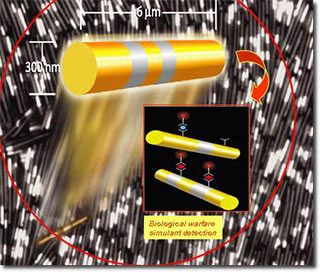| Posted: Mar 08, 2007 | |
Nanotechnology barcodes to quickly identify biological weapons |
|
| (Nanowerk Spotlight) In an effort to detect biological threats quickly and accurately, a number of detection technologies have been developed. This rapid growth and development in biodetection technology has largely been driven by the emergence of new and deadly infectious diseases and the realization of biological warfare as new means of terrorism. To address the need for portable, multiplex biodetection systems a number of immunoassays have been developed. An immunoassay is a biochemical test that measures the level of a substance in a biological liquid. The assay takes advantage of the specific binding of an antigen to its antibody, the proteins that the body produces to directly attack, or direct the immune system to attack, cells that have been infected by viruses, bacteria and other intruders. Physical, chemical and optical properties that can be tuned to detect a particular bioagent are key to microbead-based immunoassay sensing systems. A unique spectral signature or fingerprint can be tied to each type of bead. Beads can be joined with antibodies to specific biowarfare agents. A recently developed novel biosensing platform uses engineered nanowires as an alternative substrate for immunoassays. Nanowires built from sub-micrometer layers of different metals, including gold, silver and nickel, are able to act as "barcodes" for detecting a variety of pathogens, such as anthrax, smallpox, ricin and botulinum toxin. The approach could simultaneously identify multiple pathogens via their unique fluorescent characteristics. | |
| "The ability to miniaturize and adapt traditional bench-top immunoassay protocols to a fully automated micro-or nano-fluidic chip holds tremendous promise to enable multiplex, efficient, cost-effective and accurate pathogen sensing systems for both biodefense and medical applications," says Jeffrey B.-H. Tok, a researcher at Lawrence Livermore National Laboratory (LLNL). | |
 |
Multi-striped nanowires allow rapid and sensitive immunoassays for biowarfare agent simulants. (Image: LLNL) |
| The team, led by LLNL and including researchers from Stanford University, the UC-Davis Center for Biophotonics and Nanoplex Technologies, used multi-striped metallic nanowires in a suspended format to rapidly identify sensitive single and multiplex immunoassays that simulated biowarfare agents ranging from anthrax, smallpox and ricin to botulinum. The entire assay can be performed within 3–4 h, thus making it feasible to be employed on a rapid diagnostic platform. | |
| The core of this portable nanotechnology bioweapon-recognition system consists of two parts: Nanowires with a diameter of about 250 nm and a length of about 6 µm are electrochemically formed and then layered with bands of silver, gold and nickel to produce patterns that are similar to the ubiquitous barcodes found on products worldwide. | |
| The other part is an assortment of antibodies, which are essentially glued to the nanowires. Each type of pathogen calls for a unique antibody which is attached to the nanowires each antibody type with its unique "barcode". | |
| The reflection pattern and fluorescence from each stripe sequence can later be clearly recognized, similar to a barcode on a retail product. | |
| "In the end you will have a pool of various striped nanowires, each of which will have a unique antibody assigned to it, which is to detect for that particular pathogen," Tok explained. | |
| To identify pathogens, the barcoded, antibody-carrying nanowires are floated in a neutral liquid called an assay buffer, into which samples of suspected pathogens are injected. If an antigen associated with a pathogen meets its corresponding antibody, the two will join, creating a nanowire/antibody/antigen sandwich that will fluoresce, or glow, under a special light. | |
| "An important advantage of the system" Tok said, "is that many kinds of barcoded antibodies can be mixed together in the assay buffer liquid, which can be used over and over. In theory, we could interrogate for as many as 100 different striped nanowires in one single snapshot, which makes the analysis very fast." | |
| The system not only applies to biowarfare agents, but could also be used during an outbreak of an infectious disease. | |
| Ongoing work at LLNL is focused on incorporating the assay onto a microfluidic device to allow for a portable biosensing system for biological warfare agents. The platform will ultimately enable an affordable and portable multiplex biodetection system for both first responders and clinicians such that the identity of the infectious agents can be accurately detected and confirmed, thus facilitating point-of-care applications. | |
| These findings, titled "Metallic Striped Nanowires as Multiplexed Immunoassay Platforms for Pathogen Detection", have been published in Angewandte Chemie International Edition. | |
 By
Michael
Berger
– Michael is author of three books by the Royal Society of Chemistry:
Nano-Society: Pushing the Boundaries of Technology,
Nanotechnology: The Future is Tiny, and
Nanoengineering: The Skills and Tools Making Technology Invisible
Copyright ©
Nanowerk LLC
By
Michael
Berger
– Michael is author of three books by the Royal Society of Chemistry:
Nano-Society: Pushing the Boundaries of Technology,
Nanotechnology: The Future is Tiny, and
Nanoengineering: The Skills and Tools Making Technology Invisible
Copyright ©
Nanowerk LLC
|
Become a Spotlight guest author! Join our large and growing group of guest contributors. Have you just published a scientific paper or have other exciting developments to share with the nanotechnology community? Here is how to publish on nanowerk.com.
